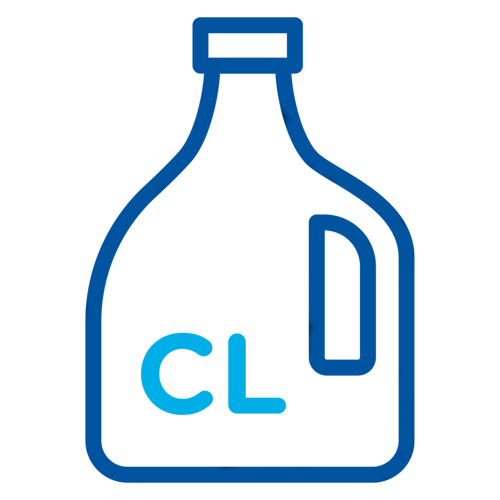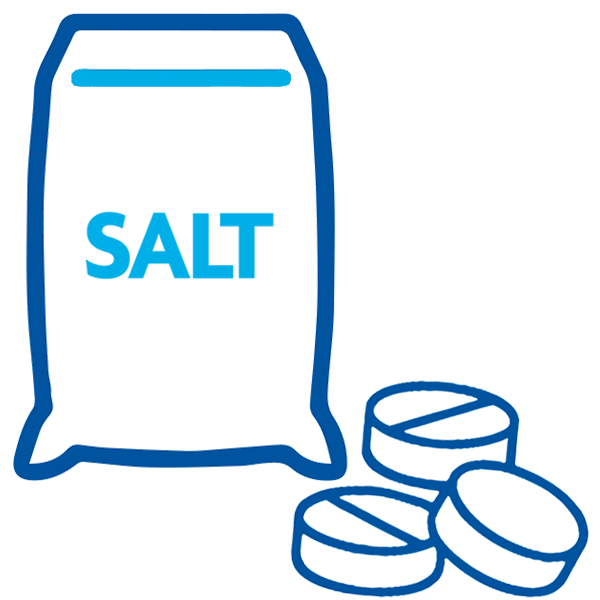Keeping pool water crystal-clear and swim-ready can be a frustrating challenge, especially during the heat of summer when algae and bacteria thrive. For pool owners who need a fast, effective, and reliable sanitizer, liquid chlorine offers a powerful solution.
Keep reading to learn more about the benefits and uses of liquid chlorine, and how to determine if it’s the right sanitizing option for your pool!
Key Article Takeaways:
- Fast Results: Quickly raises chlorine levels—perfect for green pools or pre-party prep.
- No Stabilizer or Calcium: Won’t increase CYA or hardness levels, giving you more control over water balance.
- Budget-Friendly: Great value per gallon, especially when bought in multi-packs.
- Simple to Use: No mixing or dissolving—just pour and go.
What is Liquid Chlorine?
Liquid chlorine is a professional-grade sodium hypochlorite solution with a chlorine strength between 10–12.5%. That’s nearly twice the potency of standard household bleach, and it contains fewer unwanted additives, making it ideal for pool use.
Unlike other chlorine types, liquid contains no stabilizer (cyanuric acid) and no calcium, giving pool owners more control over water chemistry. It’s also classified as a hazardous material, so proper handling and storage are essential for safety.
Key Benefits of Liquid Chlorine

Whether you use it as a daily sanitizer or weekly shock treatment, there are many benefits to incorporating liquid chlorine into your pool care routine. Some benefits include:
1. Fast and Effective
Liquid chlorine starts working immediately, quickly killing bacteria, algae, and other contaminants. This makes it highly effective for rapid sanitization and clearing up severe water issues.
2. No CYA Buildup
Unlike most trichlor tablets, liquid chlorine doesn’t add cyanuric acid (CYA) to your pool water. High CYA can lead to “chlorine lock,” where chlorine becomes ineffective. Liquid chlorine allows you to maintain optimal CYA levels for UV protection without the risk of over-stabilization.
3. No Added Calcium
Liquid chlorine does not introduce calcium into the water. This helps prevent issues related to increasing calcium hardness, such as scaling on pool surfaces, tile lines, and equipment, which can be a persistent problem in areas with hard water.
4. Cost-Effective
For many pool owners, especially those with larger pools, liquid chlorine can be a very economical choice for routine sanitization.
5. Versatile & Easy to Use
Liquid chlorine can be used for daily sanitization, routine shocking, or targeted treatments for algae blooms. Plus, it doesn’t require any pre-dissolving before use. Simply pour it directly into the pool (preferably near jets or in the deep end to aid dispersion, and ideally in the evening to minimize immediate UV degradation).
6. Neutral Long-Term pH Impact
Though its initial pH is high, the overall effect on pool pH is generally more balanced than other sanitizers.
7. Environmentally Friendly
Liquid chlorine breaks down into salt and water as it sanitizes, making it a relatively simple and less complex chemical addition to the pool water.
How and When to Use Liquid Chlorine
Whether you have a saltwater chlorine generator or use trichlor tablets as your primary sanitizer, liquid chlorine remains an invaluable tool in the arsenal of any pool owner. From daily sanitizing to targeted shock treatment, here are some of the best ways to use liquid chlorine:
For Chlorine Tab Users:

- Faster Chlorine Boosts: While tabs dissolve slowly, liquid is ideal for quick fixes after heavy use, rain, or algae.
- Helps Manage High CYA: Liquid chlorine adds no stabilizer, making it useful when CYA is already too high.
- Start-Up and Opening: It quickly establishes chlorine levels at the beginning of the season.
- pH Support: Its high pH can provide a gentle buffer in pools that lean acidic.
For Saltwater Pool Users:
- Shocking Support: Salt cells are slow to raise chlorine levels quickly. Liquid chlorine handles high-demand situations better.
- Protects Your Salt Cell: Using it for shocks reduces wear and tear on the cell.
- Winter and Cold Temps: Salt systems struggle in cold weather—liquid chlorine fills the gap.
- Troubleshooting Tool: Low chlorine output? Liquid chlorine is an instant fix while you diagnose.
- Boost for Big Problems: For heavy contamination or algae, it delivers the fast response a salt system can’t.
EXPERT TIP: While liquid chlorine works quickly to destroy contaminants and raise chlorine levels, wait at least 4 hours, or until the chlorine level is between 1 and 4 ppm, before swimming.
Important Considerations and Safety Tips
- Store Properly: Store in a cool, dry, and well-ventilated area, away from direct sunlight and incompatible chemicals. Keep it tightly sealed and out of reach of children and pets.
- Handle with Care: Always wear gloves and eye protection when handling liquid chlorine. Never mix it with other pool chemicals, especially acids, as dangerous fumes can result.
- Apply Safely: Add during the evening or night to prevent UV degradation. Pour it slowly around the perimeter of the deep end while the pump is running. Allow for full circulation before swimming.
- Monitor Water Balance Regularly: Liquid chlorine raises pH slightly, so keep an eye on your pool’s water chemistry. Test your water at least twice a week and adjust pH, alkalinity, and stabilizer levels as needed.
Liquid chlorine is a powerful, versatile, and budget-friendly sanitizer trusted by pool owners and professionals alike. Its fast action, simple use, and chemical advantages make it a smart choice for anyone looking to keep their pool clean, clear, and ready for fun.
Whether you’re maintaining daily chlorine levels, combating algae, or prepping for a big swim day, liquid chlorine delivers strong results when and where you need them. Visit your local Leslie’s or shop online to stock up—and keep your pool sparkling all season long!







